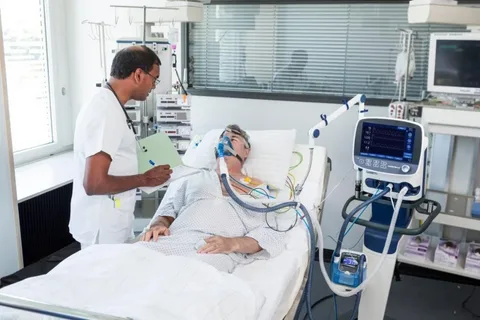"Simplified Mechanical Ventilation: Easy Step-by-Step Guide"

Mechanical Ventilation is a vital medical intervention to support or replace spontaneous breathing in patients with compromised respiratory function. It is particularly critical in intensive care units, emergency settings, and during surgical procedures. Mechanical ventilators, the devices used for this purpose, can be set to deliver breaths in a controlled manner, ensuring adequate oxygenation and ventilation.
This intervention is essential for patients suffering from conditions like acute respiratory distress syndrome, chronic obstructive pulmonary disease, and other severe respiratory ailments. Understanding Mechanical-Ventilation's fundamental principles and operational mechanics is crucial for healthcare professionals. This guide is designed to provide a comprehensive overview, breaking down the complexities into manageable steps, thereby aiding in the effective and safe use of Mechanical-Ventilation in clinical practice.
Understanding Basic Concepts OF Mechanical-Ventilation
Mechanical ventilators vary in types, such as volume-cycled, pressure-cycled, and time-cycled, each serving the same purpose of aiding patient breathing. The primary components include the ventilator machine, tubing, and interfaces like masks or endotracheal tubes. Volume-cycled ventilators deliver a set volume of air, pressure-cycled ventilators deliver air until a specific pressure is reached, and time-cycled ventilators provide ventilators air for a set period. Understanding the differences in these ventilators, alongside familiarity with essential settings like tidal volume, respiratory rate, and inspiratory/expiratory ratio, is vital. Proper knowledge of these basic concepts ensures effective operation and optimised patient care during Mechanical-Ventilation.
Preparing for Mechanical-Ventilation
A thorough patient assessment is essential, including evaluation of respiratory status, underlying conditions, and overall health. Verify that all ventilator equipment is set up properly and functions correctly. Tailor the ventilator settings to the patient’s specific requirements, considering factors such as tidal volume and respiratory rate.
Assemble the interface, whether a mask or an endotracheal tube and ensure it fits securely. Gather all necessary supplies, including suction equipment and emergency airway management tools. Establish intravenous access for administering medications and fluids. Prepare monitoring devices to assess the patient's vital signs and ventilation parameters continuously. Communication with the healthcare team is critical to coordinate care and ensure readiness for potential complications.
Initiating OF Mechanical-Ventilation
To initiate Mechanical-Ventilation, follow these steps:
1. Confirm the proper assembly and function of the ventilator equipment.
2. Securely attach the appropriate interface, whether a mask or an endotracheal tube.
3. Power on the ventilator and carefully set the initial parameters, including tidal volume, respiratory rate, and inspiratory/expiratory ratio.
4. Connect the patient to the ventilator, ensuring a stable and comfortable fit.
5. Closely monitor the patient’s response to the ventilator, observing signs of effective ventilation and adequate oxygenation.
6. Regularly check for alarms or unusual indicators on the ventilator display.
7. Adjust the ventilator settings as necessary based on continuous assessment of the patient's condition and response.
Careful execution of these steps ensures a smooth initiation of Mechanical-Ventilation.
Adjusting Mechanical-Ventilation Settings
Adjusting settings is crucial for optimising patient comfort and ventilation efficiency. Continuous monitoring of blood gas levels and lung compliance helps determine necessary changes. Adjust tidal volume to ensure adequate ventilation without causing lung injury. Modify the respiratory rate to match the patient’s needs, balancing oxygenation and carbon dioxide removal.
Assess the inspiratory/expiratory ratio to optimise breathing cycles. In cases of patient-ventilator asynchrony, fine-tune settings to better synchronise with the patient’s efforts. Review and interpret data from the ventilator display and patient monitors to make informed adjustments. Ensure any changes are implemented gradually and reassess the patient’s response to each adjustment to avoid adverse effects.
Troubleshooting Common Issues IN Mechanical-Ventilation
Common issues during Mechanical-Ventilation include alarms, patient-ventilator asynchrony, and tubing disconnections. Alarms may indicate problems such as high airway pressures, low tidal volumes, or equipment malfunctions. To resolve these, first inspect the ventilator and its connections.
Addressing patient-ventilator asynchrony often involves adjusting settings like sensitivity, flow rate, or inspiratory time to match the patient’s breathing efforts better. If disconnections occur, promptly reconnect the tubing and ensure it is secure. Regularly check for leaks, blockages, or kinks in the tubing. Continuously monitor the patient’s response and reassess ventilator settings as needed. Troubleshooting effectively requires a thorough understanding of the ventilator's functions and keen observation of the patient's clinical condition.
Weaning from Mechanical-Ventilation
Weaning from Mechanical-Ventilation is a gradual process to reduce ventilator support as the patient regains the ability to breathe independently. Key criteria for initiating weaning include stabilised respiratory status, improved underlying conditions, and adequate oxygenation without excessive ventilator settings.
The process involves systematic reduction of ventilator settings, such as decreasing the respiratory rate and pressure support. Spontaneous breathing trials evaluate the patient's ability to breathe unassisted. These trials typically involve short periods off the ventilator or on minimal support, closely monitoring for signs of respiratory distress. Adjustments are made based on the patient's tolerance and performance during these trials. Continuous assessment and readiness to revert to full support if necessary ensure a safe weaning process.
Safety and Maintenance of Mechanical Ventilation
Ensuring patient safety during Mechanical Ventilation involves monitoring for changes in the patient’s condition and promptly addressing alarms and equipment issues. Regular maintenance of ventilator equipment is crucial, encompassing routine cleaning, sterilisation, and technical inspections to prevent malfunctions.
Verify the integrity of all components, including tubing and interfaces, to avoid disconnections or leaks. Periodically calibrate the ventilator to ensure accurate delivery of settings. Staff should be trained to handle equipment swiftly and adequately perform emergency procedures. Consistently document and review maintenance activities and patient ventilation responses to identify trends or potential issues early.
Common Complications IN Mechanical-Ventilation
Mechanical-Ventilation can lead to several complications. Barotrauma occurs due to high airway pressures, causing lung injury. Ventilator-associated pneumonia arises from prolonged intubation and microbial invasion, necessitating stringent infection control. Oxygen toxicity can result from excessive oxygen delivery over time, leading to cellular damage.
Other issues include hypotension due to decreased cardiac output and tracheal damage from prolonged intubation. Regular monitoring, using the lowest adequate ventilator settings, and ensuring meticulous infection control measures are key strategies to minimise these risks. Recognising and promptly addressing complications is essential for patient safety and optimised care. Continuous education and training for healthcare professionals further aid in managing and preventing these potential issues during Mechanical-Ventilation.
Current Innovations in Mechanical-Ventilation
Recent advancements in Mechanical-Ventilation focus on enhancing patient comfort and synchronisation with the ventilator. Innovations include improved ventilator interfaces, such as more comfortable and secure masks and endotracheal tubes. New ventilation modes are designed to better align with patients' spontaneous breathing efforts, reducing the incidence of patient-ventilator asynchrony.
Integrating artificial intelligence and machine learning algorithms allows for the personalisation of ventilator settings, adapting in real-time to the patient’s changing respiratory needs. Portable and less invasive ventilators have been developed outside traditional hospital settings, offering greater flexibility in patient care. Additionally, advancements in monitoring technology provide more precise data on lung function and ventilation efficiency, aiding clinicians in making informed adjustments to treatment.
Ethical Considerations of Mechanical-Ventilation
Ethical considerations in mechanical-ventilation encompass complex decisions, often involving life-sustaining treatment. Key issues include determining the appropriateness of initiating or continuing Mechanical-Ventilation, especially in patients with limited chances of recovery. Advanced directives and patient preferences should guide these decisions, ensuring respect for autonomy.
Clinicians must weigh the benefits and burdens of prolonged ventilation, considering the patient's quality of life and potential suffering. Transparent communication with the patient and family is vital to discuss prognosis, treatment goals, and possible outcomes. Legal and institutional policies should be consulted to ensure ethical and compliant decision-making processes. Regular ethical reviews and consultations with multidisciplinary teams can provide valuable perspectives and support in navigating these challenging situations.
Conclusion
Mechanical Ventilation remains an essential intervention for patients with severe respiratory conditions. Mastery of its principles, from basic concepts to advanced troubleshooting, is crucial for optimal patient care. Healthcare professionals can benefit from further education through clinical guidelines, research articles, and professional workshops. Key resources include the latest clinical practice guidelines from reputable organisations and specialised courses offered by medical institutions. Joining professional networks and forums can also provide valuable insights and updates on best practices. Continual learning and staying abreast of technological advancements ensure proficiency in the ever-evolving field of Mechanical-Ventilation.
FAQS
Q: What is Mechanical Ventilation?
A: It assists or replaces spontaneous breathing in patients with respiratory failure.
Q: How are ventilator settings adjusted?
A: Modifications are based on patient response, using parameters such as tidal volume, respiratory rate, and inspiratory/expiratory ratio.
Q: What are some common complications?
A: Complications include barotrauma, ventilator-associated pneumonia, oxygen toxicity, hypotension, and tracheal damage.
Q: How does one wean a patient from ventilation?
A: Weaning involves gradually reducing ventilator support and conducting spontaneous breathing trials, closely monitoring the patient’s tolerance and readiness for independent breathing.
Q: What recent innovations exist in Mechanical-Ventilation?
A: Innovations include improved interfaces, new ventilation modes, integration of artificial intelligence, and advanced monitoring technologies.
Q: Are there ethical considerations?
A: Ethical considerations involve decisions about initiating or continuing Mechanical-Ventilation, guided by patient preferences and advanced directives.
|
Related Business Listings |





